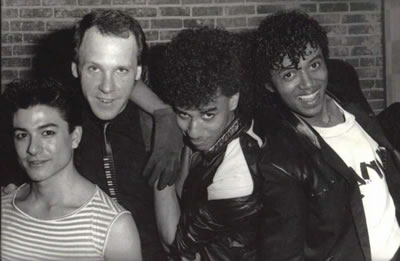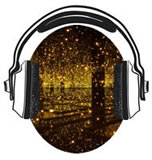
the b-side of the disco era
"Disco Demolition Night," the infamous promotional sporting event turned white riot held at White Sox stadium on July 12, 1979, is as momentous an event as any for understanding the rather abrupt end of disco as a dominant cultural trend in North America. On this evening, ninety-eight cents and disco vinyl were all the residents of Chicago's south side needed for admission to Comiskey Park, and 50,000 rock-enthusiasts showed up in droves to have their dollar-bin scores thrown into radio personality Steve Dahl's literal flaming pit of anti-disco malaise. Upon seeing the twenty thousand or so records ignited, Sox fans poured onto the field in celebration and triumph, throwing records in the air and waving anti-disco flags to the tune of Dahl's plodding and repeated roar of "disco sucks, disco sucks, disco sucks!"
More so than signaling the disintegration of disco music itself, this rather frightening affair reveals a set of social and cultural anxieties formed in the wake of disco's explosion as a musical form and site of American popular culture during the 1970s. These anxieties can be traced back to disco's unique beginnings, and are essential for understanding disco’s location within broader histories of popular music production/consumption.
Lurking for years in the underground of New York, Chicago, and Detroit's abandoned industrial sectors, disco grew up in and around a predominately gay, Hispanic, and African American club scene of indie lofts, warehouses and juke joints. Originally more of a style of selecting and arranging random R&B and soul tracks than an identifiable musical form, disco's sound developed out of the necessity to keep a packed house of drugged out club-goers alive and invigorated deep into the night and early morning.
As some of America’s first DJs (in the traditional sense of the term), once famous names like David Mancuso, Larry Levine, and Frankie Knuckles turned this emphasis on the ways in which songs and sounds interact with one another over an extended period of time into the sound of disco. What followed was a decade of huge Billboard hits like "Love Hangover" by Diana Ross, "Funky Town" by Mouth to Mouth, "Don't Stop 'Til You Get Enough" by Off The Wall, "Dancing Queen" by Arrival, and the list goes on.
According to Tim Lawrence in Love Saves The Day, America's eventual hostility toward disco can be traced back to these earlier days. For him, these underground urban spaces challenged capitalist (re)production and the heteronormative structures of American life. Commenting on a string of off-the-grid party spots such as the Loft and Paradise Garage (NY), the Warehouse (Chi), and the Musical Institute (Det), Lawrence describes the mood of the disco scene as such: "When clocks are nowhere to be seen, time starts to dissolve, and this provided the dancers with the opportunity to forget their socialized selves--the person who has to get up at a certain time, take lunch at a certain time, leave work at a certain time, etc" (24).
Once absolved of their relationships to time and labor, Lawrence suggests that the particular formulations of sound and space experienced on the disco dance floor propelled these club-goers into new and unexpected moments of cross-cultural communication and intimacy. "The secure and cocoon-like contours of the dance space created the perfect milieu for experimental regression," he says. "Unable to avoid body contact on all sides, individual dancers had little choice but to dissolve into an amorphous whole."
As a concrete example of this world, he offers Frankie Knuckles' description of The Loft: "[y]ou could be on the dance floor and the most beautiful woman that you had ever seen in your life would come and dance right on top of you...Then the minute you turned around a man who looked just as good would do the same thing. Or you would be sandwiched between the two of them, or between two women, or between two men, and you would feel completely comfortable."
Thus, paired against the hard-nosed, masculinist, and pseudo-proletariat 1970s American rock n' roll culture of "sex, drugs, and ~way too many bros with guitars~," disco's odd and subtle sound came to represent a world of cross-cultural communication, fluid sexuality, and anti-capitalist sentiment. Within the cramped and dimly lit architectural environments of an urban industrial sector "left behind" by a techno-obsessed and increasingly global American socio-political economy, disco offered a counter-narrative of space, time and social interaction to those readily available in "mainstream" American life.
It is no surprise then that, after Billboard 100 swallowed disco whole, and John Travolta frothed America's loins vis-à-vis some high heels and a pair of white slacks in Saturday Night Fever, something had to give: Enter White Sox fans stage ~right~ → July 12, 1979, Disco Demolition Night → July 21, 1979, the top six records on the U.S. music charts were disco songs → September 22, 1979, no disco songs in the US Top 10 chart.
More seriously though, the "end" of disco probably came as the result of this its movement into a realm of popular culture recognizable enough for a mass audience to rally against. Indeed, as the 1970s wore on, disco traveled from its discrete location in the urban underground to hugely visible sites of popular culture such as Studio 54 in New York, the American cinema, and Billboard charts across the world. At the same time that its original infrastructure was targeted by city-wide, proto-gentrification campaigns to "clean-up" urban space for the sake of public "safety," its sound increasingly became the product of industry giants like Columbia Records, Capital Records, and the NARAS (National Academy of Recording Arts and Sciences --the Grammys--).
What is significant about this moment in the history of American popular music, however, are the ways in which artists came to maneuver popular circulation at a crossroads between the material and technological reproduction of sound. For with the successful release of every top-selling R&B, soul, and disco record, producers and sound engineers were charged with the task of composing (their interpretation) of the track’s instrumental "version." Thus, via the b-side of platinum and gold vinyl from the 1970s, the "dub" finally landed on American soil.
Michael Veal’s book, Dub: Soundscapes and Shattered Songs in Jamaican Reggae, offers one of the more coherent definitions of "dub" I’ve seen. Although his book focuses on Dub, the sub-genre of reggae, his definition also works for the dubs that Americans would stumble upon post-disco. He says that "dub mixes are remixes of pieces that originally contained lyrics," that the dub mix "may be at least partially understood as extending the concerns of the song lyrics into (relatively) instrumental or ‘pure sound’ territory," and that "the extensive use of reverberation/delay devices and the fragmentation of the song’s surface are probably the two most immediately recognizable features of dub music" (196).
After outlining these general characteristics, Veal poses several powerful questions about the cultural significance of these "fragmentary texts." In a rather memorable description of a hypothetical music symposium curated by unidentified musicheads from the future, he asks: "what deeper resonances might be gleaned from these skeletal remains of gutted pop songs with their reverberating language of fragmentation and erasure?"
For Veal, these deeper resonances--particularly dub’s experimental use of echo--signal a "sonic metaphor for the conditions of diaspora." What with dub reggae and diaspora’s similar relationships to (musical and historical narrative) rupture, as well as the apparent link between "spatiality in the music" and "Afro-inflected imaginings of outer space, science fiction and the future," Veal theorizes dub reggae as a lexicon for tracking the ways in which "this strange and seemingly inscrutable music played an important role in the ongoing evolution of Jamaica’s postcolonial culture" (197).
Puts on In Dub Conference, Vol 1
Enter Afrofuturism stage ~left~
Vibes
But this becomes confusing when we think about dub translated into other social and cultural contexts. Indeed, because of its international success, once expedited, disco descended on the world like the fluid and "amorphous whole" that its dancefloor inspired. And wherever it went, the dub followed close behind, primed and ready to be reimagined in unique and innovative ways. True, by the early 1980s, disco seemed to be on the outs, but that's because it had traveled the world, interfaced with various forms of funk, soul, electronica, industrial and new wave music, and been filtered through the mixing and sound processing technologies of the studio to the point that its foundational sounds were virtually unrecognizable.
The same can be said for dub reggae in a way: its influences, particularly as a heuristic and in terms of techniques of sound engineering, are as if not more prevalent in the history of global popular music than disco. But the artists below, in deploying echo/reverb, instrumentals, and remixed lyrics to explore the inner musical workings of pop songs, somehow seem more interested in piecing sonic landscapes together than dwelling in rupture and fragmentation. With the synthesizer as their instrument of choice, they merge chaotic syncopation with a steady "four-on-the-floor" beat in a way that allows for experimentation at the same time that it clings to a purposeful and uninterrupted narrative arc.
As such, while the above section tracks disco’s explosion and transformation in America, this account barely scratches the surface of its eventual reach. The following audio and tracklist makes up for this by documenting "that disco beat" as expressed within socio-cultural contexts as far reaching as Italy, Cameroon, Niger, Spain, India, and East Texas.
I ask then, what deeper resonances can be gleaned from these skeletal remains of gutted pop songs with their reverberating language of synthesis and erasure? Not diaspora, for the artists below are descendants of disco, music that formed in the wake of huge networks of cross-cultural communication and intimacy. Not solidarity, because solidarity implies some level of agency/choice, and, as you’ll remember, the disco dancefloor generates rather than encourages social interaction and contact. What then?
Well, as you'll see and hear in the following audio and tracklist, they too arrive at engagements with spatiality, Afro-inflected imaginings of outer space, and displacement.
Flips over "Don't Dsturb This Groove" by The System
Enter Afrofuturism stage ~left~...again
**Wait, is this still cool? I can't tell.
| 0:00 | "Mar De La Tranquilidad" - Azul Y Negro - Me Estoy Volviendo Loco |
| 4:06 | "Don't Fall Apart On Me (feat. Antoinette Marie Pugh)" - Jeff Phelps - Magnetic Eyes |
| 9:19 | "Millions of Sensations" - Dub Oven - Skin 'N' Bones |
| 13:23 | "Master Ship" - Starship Commander Wooooo Wooooo - Master Ship |
| 19:40 | "Dangay Kotyo" - Mamman Sani - Taaritt |
| 23:51 | "Freedom (instrumental) - Thanya - (1982) |
| 29:45 | "Melody" - Plustwo - (1983) |
| 33:41 | "Enjoy Your Life" - Oby Onyioha - I Want To Feel Your Love |
| 38:56 | "Don't Challenge Me" - Makers |
| 41:57 | "Groove" - The System - Don't Disturb The Groove |
| 47:11 | "Teaser" - Toney Lee - (1985) |
| 52:00 | "I Wanna Freak (Dub)" - The Chance - (1983) |
| 58:13 | "Set Fire To Me (Inferno Dub)" - Willie Colón - (1986) |
| 1:02:13 | "Disco From A Space Show" - Guitar Red - Hard Times |
| 1:05:48 | "Savannah Georgia" - Francis Bebey - Savannah Georgia |
| 1:09:15 | "Raga Kalvati" - Charanjit Singh - Ten Ragas to a Disco Beat |
| 1:14:17 | "Love Is A Hurting Thing" - Gloria Ann Taylor - Deep Inside You |
| 19:40 | "Wrong Space, Wrong Time" - Jeff Phelps - Magnetic Eyes |
